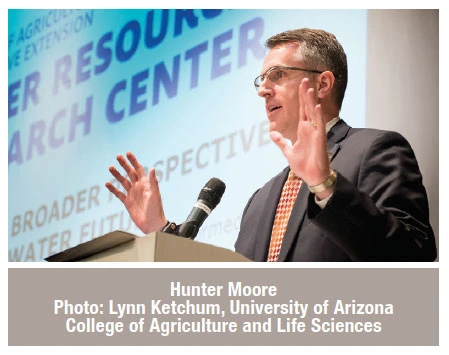Hunter Moore, Natural Resources Policy Advisor to Arizona Governor Doug Ducey 

Summer’s heat has arrived with its usual triple-digit fury, and with it, you can sense a heightened awareness of the challenges we in the Southwest face in protecting our water resources.
In an arid climate like ours, we must be constantly vigilant about the health of our water supplies.
The challenges are well known. The potential for experiencing shortfalls in Arizona’s Colorado River allocations sometime in the near future is increasing. And the water levels in Lake Mead — the great storage reservoir for Arizona’s Colorado River water — are dropping.
Residents of some regions of the state that are particularly reliant on groundwater are concerned about the condition of their aquifers. And not unjustifiably so, in many cases. Arizona Department of Water Resources hydrologists are finding that well depths in groundwater-reliant regions like Cochise County and the West Basins of La Paz County are dropping, and residents with shallow wells in parts of La Paz and Mohave counties fear they are beginning to see the same thing happen there.
Governor Doug Ducey has put a premium on protecting Arizona’s invaluable water resources. In his State of the State speech in January, the governor noted Arizona’s long legacy of far-sighted leaders in water policy and vowed to continue their tradition:
“Right now, a team of our top water experts, users, and providers is charting the path forward,” he said.
That includes the team of leaders the governor began gathering early in his administration to participate in his Arizona Water Initiative, a two-pronged, “parallel-track” strategy for collecting accurate data on the condition of our water supplies statewide and for determining the best means of augmenting those resources.
Right now, the Water Resources hydrological teams are crisscrossing the state, measuring the depth of wells and updating the record on the health of Arizona’s underground aquifers.
They are systematically gauging the status of water supplies in 22 separate “planning areas” around the state and are seeking out local stakeholders for ideas on how best to resolve the issues they outline.
The Governor’s Water Augmentation Council, meanwhile, is studying innovative ways of adding to the Arizona water pool.
Created by executive order last Fall, and with 29 members, the GWAC advises Gov. Ducey on the best means of adding to the supply. Those include direct augmentation strategies such as enhanced water re-use and desalinization, as well as conservation efforts.
The effort is long-term. The council — comprised of water-resources experts, watershed advocates, local government officials and leaders of Arizona’s agricultural, mining, and other industries — is tasked with resolving imbalances between the needs of a growing statewide population and available water supplies.
Demand in our dynamic home state is destined to grow.
Water demand in Arizona is expected to exceed supply by as much as three million acre-feet within 100 years, according to an analysis performed by the Water Resources Development Commission. As summarized in ADWR’s Strategic Vision report, imbalances are expected to begin to materialize in the next 20 to 30 years. So we have time to craft solutions.
Obviously, the road ahead for the council is a challenging one.
Among the topics at the top of its list of statewide and regional strategies is the resolution of Indian and Non-Indian water-rights claims — a long-running impediment to gaining control of the state’s water resources. Former U.S. Senator Jon Kyl, perhaps the premier expert on Southwestern water law, has identified completion of these “general stream adjudications,” as they are known, as a vital step forward for gaining solid control of Arizona’s in-state water resources.
The council will not be shying clear of controversy, either (a virtual impossibility where water is concerned, regardless).
The group will look at reforming the state’s practice of in-state water transfers. Other Western states have developed market-based water-rights transfer models. Arizona could consider those models, too. And we expect the augmentation council will be taking a good look at them.
Water re-use is an important part of the Strategic Vision. And with good reason. Recycled or re-used water will make up a significant portion of the additional municipal supplies Arizona will need to accommodate a growing economy and population.
As with all things of value, an investment in Arizona’s water future will carry a price tag. The council will be examining potential financing mechanisms for upgrading and maintaining the state’s water-delivery infrastructure.
That may include a substantial investment in desalinization.
As noted in the Arizona Water Initiative annual report released in May, Arizona may need to import water supplies derived from ocean water desalinization to augment its existing supplies of surface water and groundwater.
Arizona has a lengthy and laudable history of water planning efforts.
Those efforts have provided us the space to conduct long-term planning initiatives like those now on the agenda of the Governor’s Water Augmentation Council.
That’s where good planning gets you — assuring that water supplies are always available, a critical feature of Arizona’s long-term economic and social stability.
That’s the idea. That it is always there.
Even on the hottest, driest days of the year.


